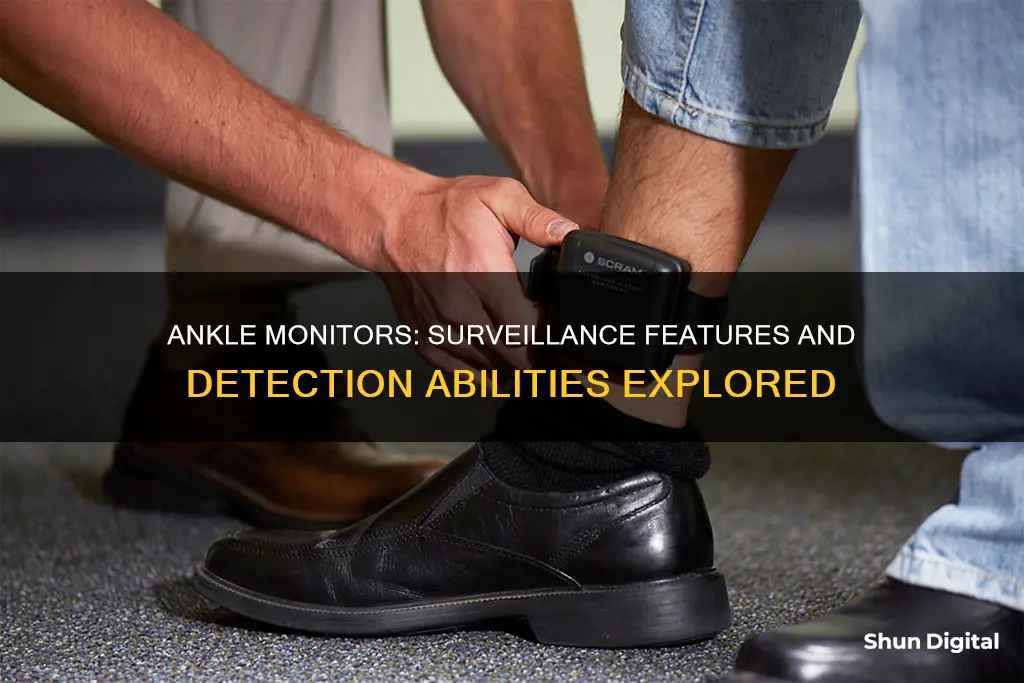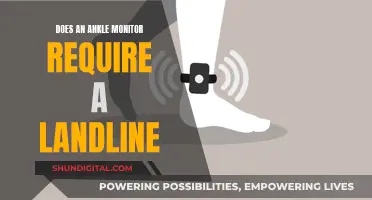
Ankle monitors are often used as an alternative to incarceration, allowing individuals to be punished without being placed in prison. They are typically used for those who are awaiting trial, on probation, or have been convicted of a non-violent or lesser crime. The monitors use GPS technology or radio frequency to transmit location data to a monitoring centre, ensuring compliance with court-ordered movement restrictions. In addition, some ankle monitors can detect alcohol consumption, making them particularly useful for enforcing restrictions on individuals with alcohol-related offences. The use of ankle monitors has been a growing trend, with over 100,000 people in the criminal justice system under some form of electronic monitoring. While this technology can help reduce the prison population and ensure compliance with court orders, it has also raised concerns about privacy and dignity, with some arguing that it amounts to e-carceration.
| Characteristics | Values |
|---|---|
| Purpose | To ensure the wearer doesn't get into more trouble; to ensure the wearer stays within boundaries set by the court; to be used as an alternative to jail time; to reduce bail |
| Who wears them | People awaiting trial; people deemed a danger to the community or a flight risk; people convicted of an offence; people deemed low-risk offenders; people on probation or parole; people facing immigration proceedings |
| Type of crime | Serious crimes such as murder, sexual assault, or major drug offences; repeat offenders; DUI or DWI; domestic violence |
| How they work | Transmits a signal to a base unit, usually located in the home; if the wearer goes outside the designated area, the device vibrates and emits a loud tone; if the wearer doesn't return, the device sends an alert to the authorities |
| Features | Waterproof; lightweight; two-way communication capabilities; speakers and a microphone; 60-hour battery life; tamper-proof alarm |
| Cost | Installation fee: $50-$100; daily monitoring fee: $10-$15; monthly cost: up to $300; setup charges: $100-$200; daily fees: $3-$35 |
| Alcohol detection | Tests the wearer's sweat every 30 minutes, 24 hours a day, for the presence of alcohol; detects alcohol in the wearer's sweat; tests for "transdermal" alcohol concentration |
What You'll Learn

Detecting alcohol consumption
Ankle monitors, also known as SCRAM (Secure Continuous Remote Alcohol Monitor) bracelets, are often used to detect alcohol consumption in DUI offenders. The bracelets are equipped with transdermal alcohol testing technology, which tests the wearer's perspiration for alcohol content every 30 minutes. This is based on the fact that about 1% of ingested alcohol is excreted through "insensible perspiration", where a small amount of ethanol vapour passes through the skin.
The SCRAM CAM bracelet automatically transmits testing data to a wireless base station, where it is stored and uploaded to monitoring software. If an alert is generated, a trained analyst will review the data and notify the supervising authority of any violations. This continuous, automated monitoring eliminates the opportunity for the wearer to drink around test schedules and also distinguishes between consumed alcohol and environmental alcohol sources.
The SCRAM bracelet is typically ordered by a court of law as a penalty for DUI/DWI arrests, especially for second and third-time offenders. It can also be used as a pretrial condition of probation or as an alternative to a jail sentence, helping to ensure the offender maintains sobriety and complies with court orders.
While the SCRAM bracelet is generally accurate, there are times when false readings can occur. For example, products containing alcohol, such as perfume, lotions, mouthwash, and hand sanitiser, could potentially set off the monitor. Additionally, certain medical conditions affecting metabolism may also lead to false readings. However, SCRAM systems usually consider it a "positive consumption violation" if the wearer's blood alcohol content (BAC) is 0.02% or higher.
Easy Guide: Install Vivid Pixel on Your ASUS Monitor
You may want to see also

Tracking location via GPS
Ankle monitors are typically strapped to the lower leg with a tamper-proof band. They are about the size of a pager and are equipped with GPS and A-GPS location technology. The GPS location is determined by radio frequency (RF) signals transmitted to a base unit, usually located in the home and connected to a landline phone. If an individual moves outside of a designated area, the device vibrates and emits a loud tone, notifying them that they are about to breach the conditions for their release. If they do not return to the designated area, the device sends an alert to the authorities.
SCRAM GPS Analytics takes the 1,440 location points a client generates per day and presents them as clean, easy-to-view information. This allows officers to quickly interpret client movements by reviewing stop patterns, charging, and alert analysis. With Google Maps and Google Info windows built into the SCRAM GPS monitoring software, officers can quickly identify a client's exact location and understand their movements in context.
The GPS tracking of ankle monitors is used to ensure that individuals adhere to the conditions set by the court, such as sticking to a specific area, avoiding certain people, or adhering to a curfew. This is especially relevant for individuals deemed a flight risk or a danger to the community.
Brain Monitoring: Buying Advanced Technology for Better Insights
You may want to see also

Two-way communication
The two-way communication capability in ankle monitors allows wearers to interact with authorities and can be a valuable tool for individuals who need ongoing support or supervision. This feature ensures that the wearer can quickly reach out for help or assistance when needed.
In addition to the two-way communication feature, these ankle monitors also incorporate GPS and RF technology to track the wearer's movements. This combination of features provides a comprehensive solution for monitoring and assisting individuals who require ongoing support or supervision.
The two-way communication functionality adds a layer of interactivity to the monitoring process, allowing the wearer to have direct conversations with monitoring personnel. This can be particularly useful in situations where the wearer needs to provide additional information, explain certain actions, or request assistance.
The two-way communication ankle monitors are just one type of ankle monitor available. Other types include GPS ankle monitors, RF ankle monitors, hybrid ankle monitors, alcohol monitoring ankle monitors, and tethered ankle monitors. The choice of ankle monitor depends on the specific needs and requirements of the individual being monitored.
Blind Spot Monitor: A First Year Essential?
You may want to see also

Alerting authorities when leaving designated areas
Ankle monitors are a form of electronic monitoring used by law enforcement to track the movements of individuals who have been placed under house arrest, on probation, or are awaiting trial. One of the key capabilities of ankle monitors is their ability to alert authorities when an individual leaves a designated area.
Ankle monitors are equipped with GPS technology or radio frequency transmission to track an individual's location. If a person wearing an ankle monitor ventures outside of a court-designated area, the device will first vibrate and emit a loud tone, notifying the wearer that they are about to breach the conditions of their release. If the individual does not return to the designated area, the ankle monitor will send an alert to the relevant authorities, such as the police or a monitoring service center. This capability ensures that individuals adhere to their movement restrictions and can facilitate timely intervention by authorities if needed.
The designated areas that an individual must stay within are typically set by a judge and are based on the specific circumstances of each case. For example, an individual under house arrest is usually restricted to their home address, while others may be permitted to travel to work, religious services, court hearings, medical appointments, or rehabilitation services. In some cases, travel outside the home may be restricted to specific times and must be scheduled in advance so that authorities are aware of the individual's whereabouts.
The ankle monitor's ability to alert authorities when an individual leaves a designated area serves multiple purposes. Firstly, it helps ensure the individual's compliance with court-ordered restrictions. Secondly, it can assist in reducing the need for constant physical supervision by law enforcement officers, as the monitor provides real-time updates on the wearer's location. Additionally, this capability contributes to community supervision initiatives, where individuals are monitored by law enforcement but remain within their community instead of being incarcerated.
While ankle monitors can provide valuable surveillance information, their use has also raised concerns about privacy and dignity. Some newer models have incorporated two-way communication capabilities, allowing officers to contact individuals directly through the device. This feature has been criticized for potentially infringing on attorney-client confidentiality and violating the constitutional right to counsel, as conversations with attorneys could be overheard. As a result, there are ongoing discussions about balancing the benefits of electronic monitoring with the need to protect the rights and rehabilitation of those under supervision.
Blind Spot Monitor: Is It Standard on the Toyota Prius?
You may want to see also

Monitoring heart rate and blood pressure
Ankle monitors are typically used to track the movements of individuals who have been sentenced to restricted travel or activities. They can also be used to monitor alcohol consumption.
A new generation of ankle monitors offers a range of advanced features, including two-way communication capabilities. One such device, the ReliAlert XC3, offers speakers and a microphone, which theoretically enable two-way communication between the wearer and law enforcement.
While these new devices do not appear to be widely used, one watch-like monitoring device has been advertised with the promise of "calling features, motion sensors, vibration alerts, messaging, heart rate and blood pressure detection."
It is important to note that the primary purpose of ankle monitors is to track an individual's movements and location, and the use of more advanced features, such as heart rate and blood pressure monitoring, may raise concerns about privacy and dignity.
In the context of monitoring heart rate and blood pressure, ankle monitors could potentially be used to gather physiological data, providing insights into an individual's health condition, sleep patterns, or even mood. This type of monitoring could be seen as a massive, potentially ongoing invasion of privacy, even for those on probation, who have diminished rights in this regard.
Additionally, the accuracy of such measurements by an ankle-worn device may be questionable, as traditional heart rate and blood pressure monitoring is typically done on the wrist or upper arm.
Asus ROG Monitors: Worth the Hype and Price?
You may want to see also
Frequently asked questions
An ankle monitor is a device worn around the lower leg to track the movements of individuals who have been sentenced to restricted travel or activities.
Ankle monitors use GPS technology or radio frequency to transmit location data to a monitoring centre, alerting the proper authorities if the wearer breaches their court-ordered movement restrictions.
Ankle monitors can detect the wearer's location, alcohol consumption, and attempts to remove or tamper with the device.







